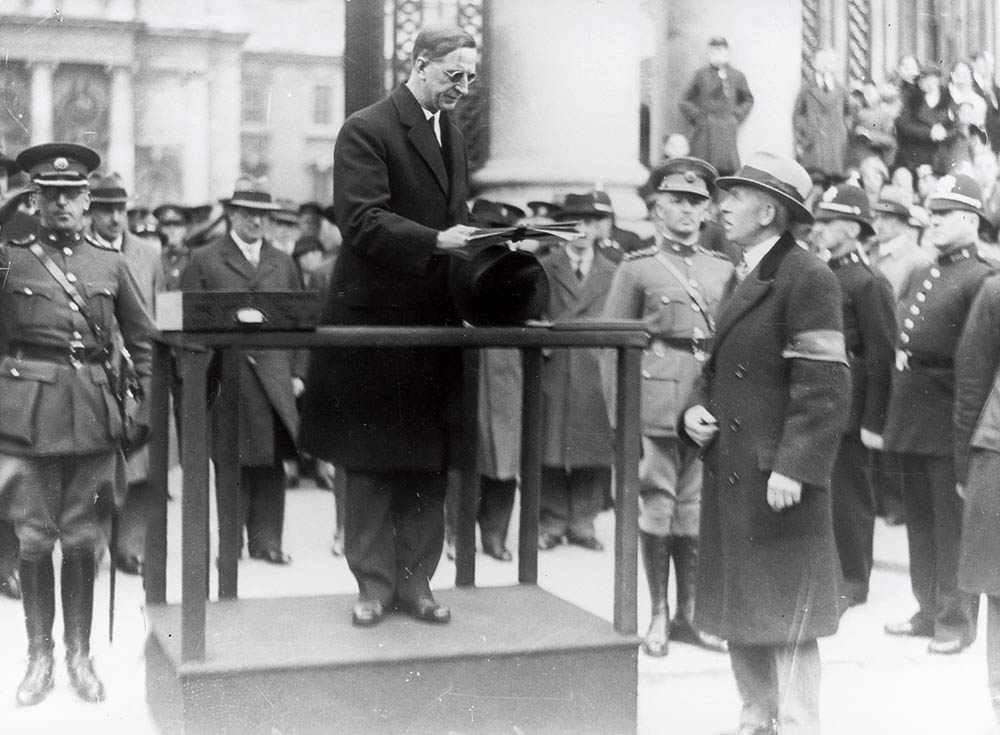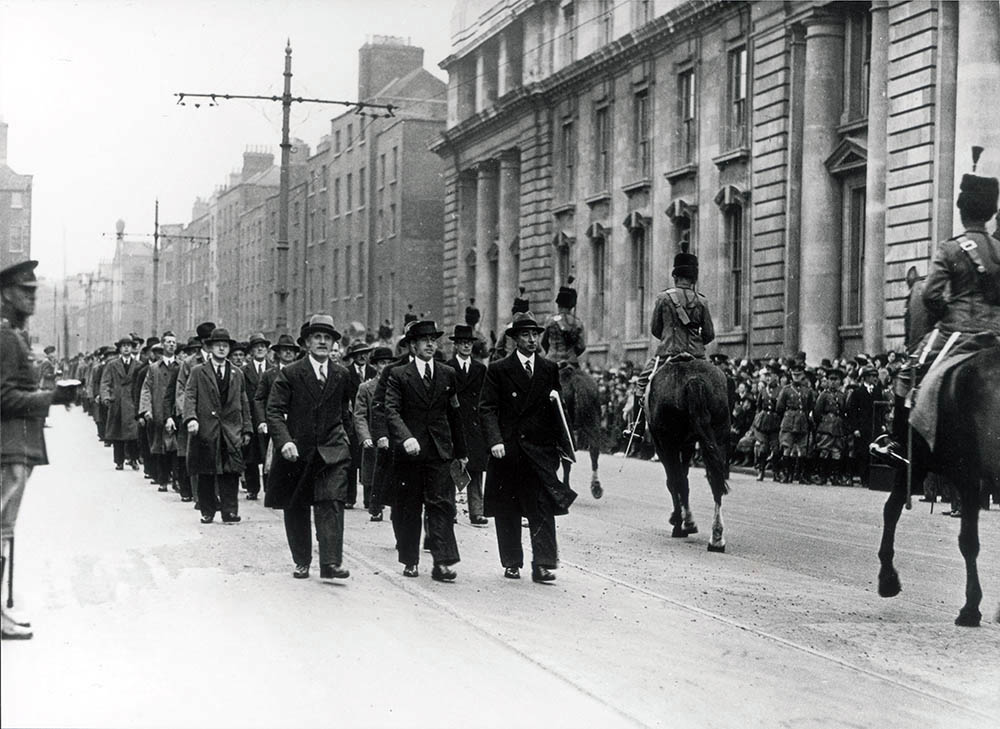Background to the Roll of Honour of 1916
Article published in History Ireland Issue 2(Mar/Apr 2006) Volume 14
‘At the request of the Easter Week Memorial Committee, a number of persons who participated in the Easter Week Rising,
1916 … undertook the task of preparing an authentic list … of those … who served in this post during the Rising. This
task … was a necessary preliminary to the complication of an Easter Week Roll of Honour, which it is the intention of
the … Committee should be signed by all surviving participants in the … Rising, and lodged in the National Museum as a
national document.’
The Roll of Honour of 1916 was presented to the government on 24th May 1936 in a ceremony in front of government buildings on Merrion Street.
The guard of honour was composed of a company of the regular Irish Army and a detachment of the Volunteer Force led by a Lt Vivion de Valera.
The ceremony began with the president of the executive council since 1932 and the highest-ranking surviving officer of the Rising, Èamon de Valera,
taking the salute from over 1,000 survivors of 1916.
The garrison rolls (45 pages) were presented to him, the first for the GPO, and the remainder of the garrisons in alphabetical order: Ashbourne,
Boland's Mills, Cabra Bridge, City Hall, Four Courts, Jacob’s Factory, Magazine Fort, Marrowbone Lane, Mendicity Institute, St Stephen’s Green and
South Dublin Union. They were then handed to Liam Gogan, another survivor of the Rising and member of staff of the National Museum of Ireland. Each
garrison was broken down into two parts: (a) surviving members and (b) those executed, killed in action or since deceased.
In 1936 there were 1,104 names on the surviving members roll and 254 names of those executed, killed in action or since deceased. All of the rolls included
the signature of the person and some also included rank and unit. Only in the rolls of the GPO, City Hall and St Stephen’s Green was a distinction made in the
latter figure between those killed in action and those who had since died.
While accepting the rolls from de Valera, Liam Gogan stated that ‘it would be a good idea to make another attempt to correct the lists, and to include whatever names
are missing, or erase names erroneously included, at the discretion of the committee’, which suggests that the roll was not complete. Over the years there have been various
attempts to calculate how many people actually fought in the Rising. In 1916 the Weekly Irish Times published 1916, rebellion Handbook, and recorded that 3.226 men and 77 women,
of whom 160 were convicted by courts martial, 23 acquitted, and 1,852 interned. In Frongoch, University of Revolution Sean O’Mahony lists 1,804 names taken from prisoners’ camp
register maintained by the general council of Frongoch. He also notes that ‘ideally I would have liked to work with the British register but could find no such record in the Public
Records Office’. In ‘The Easter Rising in Dublin: the military aspects’ for the Irish Sword, Col .P. J Hally breaks down the numbers as follows on the first day of the Rising but
accepts that these numbers increased as the week developed:
| Battalion |
Garrison |
Total |
| 1st Battalion |
Four Courts, Church St., King St. |
150 |
| 2nd Battalion |
Jacob's Factory, Kevin St., Camden St., |
130 |
| 3rd Battalion |
Boland's Bakery, Grand Canal St., Westland Row, Northumberland Rd., |
120 |
| 4th Battalion |
South Dublin Union, Marrowbone Lane, Roe’s Malt House, Watkins Brewery |
150 |
| Ashbourne |
(20 men to GPO) |
29 |
| Citizen Army |
St Stephen’s Green, City Hall Area |
180 |
| Hibernian Rifles |
GPO |
20 |
| Special Force |
Mendicity Institute |
30 |
| HQ and Protective Troops |
O’Connell St., Henry St. |
150 |
|
Total
|
|
969
|
A summary of the military service pensions also complicated the matter. There were 86,608 applications under the 1924, 1934 and 1949 Army Pensions Acts of which 17,849 pensions were
awarded to those who had proven service between 23 April 1916 and 30 September 1923. There is no breakdown for those who specifically fought in 1916 but it is believed to be the same
as the number of 1916 medals issued on the 25th anniversary in 1941, of which there were 2,477 recipients. However, as can be seen from the number of failed applications, the civil service
did not take the issuing of a pension lightly.
Until the administration of the Military Service Pension Acts by the Department of Defence was finished on 30 September 1958, the onus of proof
rested on the applicant, who went before a board of assessors consisting of three members, one of whom was a practising barrister or serving judge.

At the handover of the rolls in May 1936 there is no mention in the press reports of the presence of either the Labour Party or Fine Gael. The signatures of W.T. Cosgrave, Desmond Fitzgerald
and Joseph McGrath (all members of the Cumann na nGaedheal government of 1923-32) are on the roll, yet Richard Mulcahy is notably absent from the Ashbourne garrison. Of the succeeding
Fianna Fáil government (1932-7), seven members signed the roll, including Èamon de Valera, Sean T. O Ceallaigh, Sean Lemass and Oscar Traynor. Indeed, it is noted in the press coverage
that members of the cabinet marched in the parade. So it would appear that twenty years after the Rising the signing of the roll was overshadowed by the same Civil War divisions that have dominated
Irish politics until recently.
In light of these discrepancies, and in particular the difference between the number of pensions and the original roll, a procedure was developed whereby names could be added to the rolls on the request of the Department
of Defence. However, before this procedure was adopted the garrison committees added some names. Therefore the Roll of Honour was not complete when it was presented to the National Museum in 1936, and to rectify this 276 signatures
have been added to the roll of surviving members and 29 to the roll of those executes, killed in action or since deceased. There was also the addition of two new garrisons – Roe’s distillery and Louth and Meath – and the addition of an extra
page of names for the Four Courts. The complete Roll of Honour can therefore be broken down as follows:
| Garrison |
Total |
Women |
Deceased |
| GPO |
416 |
56 |
59 |
| St.Stephen's Green |
142 |
19 |
25 |
| Boland's Mills |
177 |
0 |
29 |
| Jacob's Factory |
188 |
10 |
38 |
| Cabra Bridge |
8 |
0 |
N/A |
| City Hall |
46 |
10 |
16 |
| Four Courts |
306 |
34 |
48 |
| Mendicity Institute |
24 |
0 |
7 |
| Ashbourne |
59 |
6 |
13 |
| Magazine Fort |
12 |
0 |
N/A |
| Louth & Meath |
95 |
1 |
N/A |
| Roe's Distillery (1947) |
18 |
0 |
5 |
| Marrowbone Lane |
138 |
21 |
19 |
| South Dublin Union |
62 |
0 |
14 |
|
Total
|
1655
|
157
|
283
|

While there are discrepancies between the number of pensions and the number of signatures, the Roll of Honour is still an important historical document. After many years on display, the Roll of Honour of 1916 was removed for
conservation reasons and access could only be given by appointment. This year the rolls are being scanned so that they can be electronically access in the Irish Military History Exhibition, which is set to open this summer at
the National Museum of Ireland at Collins Barracks and on the Museum’s website. The new 1916 exhibition is due to open during the week of the 90th anniversary of the Rising in April 2006.
Labhras Joyce and Brenda Malone are Assistant Keepers at the National Museum’s Art and Industrial Division, Collins Barracks.
History Ireland March/ April 2006
Images:
(top):De Valera receiving the Roll of Honour in Mary 1936 (National Museum of Ireland)
(bottom):Survivors of the Rising being taken into custody. (National Museum of Ireland)
Download a printable version of this page
